


xxxxxAs we have seen, it was the
French inventor Joseph Niépce who, in 1827
(G4), produced the first permanent
photograph - a blurred image of his back courtyard. The
exposure time required, however, was up to eight hours or more, and
it was in an attempt to reduce this time that he went into
partnership with Louis J.M. Daguerre, a Parisian painter. In 1839 Daguerre managed to cut
this time considerably by a single-image process which used
plates coated with iodized silver. He sold the idea to the French
government that year, and his prints or “daguerreotypes” were soon
being produced across Europe and North America. And when the
Hungarian mathematician Jozsef Miska Petzval invented his improved
lens in 1841, cutting the exposure time to well below a minute,
photography became a flourishing business, especially in the United
States. As we shall see, his method was eventually superseded by the
negative/positive process invented by the English chemist William
Henry Fox Talbot. Known as calotype or talbotype, this was able to
produce a number of prints from a single negative.
LOUIS JACQUES MANDÉ DAGUERRE
1787 - 1851
(G3b, G3c, G4,
W4, Va)
Acknowledgements
Daguerre: detail,
daguerreotype by the French painter and photographer Jean-Baptiste
Sabatier-Blot (1801-1881), 1844 – International Museum
of Photography and Film, George Eastman House, Rochester, New
York. Boulevard du Temple: taken by
Daguerre in 1839, from The Photography
Book, Phaidon Press, London, 1997 –
Bayerisches Nationalmuseum, Munich, Germany. Fox Talbot: detail, by the Scottish photographic artist John
Moffat (1819-1894), 1864 – Fox Talbot Museum, Lacock Abbey,
Wiltshire, England. Window: taken by Fox
Talbot, 1835 – Fox Talbot Museum, Lacock Abbey, Wiltshire,
England. Articles in China: this copy at
the Metropolitan Museum of Art, New York. Boston:
by the American photographer James Wallace Black (1825-1896),
1860 – Metropolitan Museum of Art, New York.
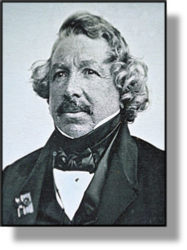 xxxxxAs we have seen, it was the French inventor Joseph
Niépce who, in
1827 (G4),
produced the world’s first permanent photograph taken from nature -
a blurred black and white image of the courtyard at the back of his
house. This was a remarkable achievement, but there remained the
problem of the very long exposure time needed to produce the
photograph, a matter of eight hours or more. It was because of his
failure to reduce that time, either by chemical or optical means,
that in 1829 he decided to go into partnership with Louis J.M.
Daguerre, a Parisian painter and printmaker (illustrated), who was fascinated by the idea of photography, and
very keen to develop this new art form.
xxxxxAs we have seen, it was the French inventor Joseph
Niépce who, in
1827 (G4),
produced the world’s first permanent photograph taken from nature -
a blurred black and white image of the courtyard at the back of his
house. This was a remarkable achievement, but there remained the
problem of the very long exposure time needed to produce the
photograph, a matter of eight hours or more. It was because of his
failure to reduce that time, either by chemical or optical means,
that in 1829 he decided to go into partnership with Louis J.M.
Daguerre, a Parisian painter and printmaker (illustrated), who was fascinated by the idea of photography, and
very keen to develop this new art form.
xxxxxNiépce never lived to see
any significant reduction in the exposure time, but Daguerre, using
his partner’s materials and literally stumbling by chance upon the
solution, succeeded where he had failed. By 1838 he had reduced the
exposure time considerably by means of a single-image process
which used copper plates coated with silver nitrate. In January the
following year, 1839, a detailed account
of this new method was given to the Académie des
Sciences by the French physicist François Arago, and in
August of that year Daguerre made the method public, naming it the
“daguerreotype process”. Such was the response to this invention
that within a matter of months Daguerre and Niépce’s son Isidore
were able to sell the process to the French government in return for
generous government pensions.
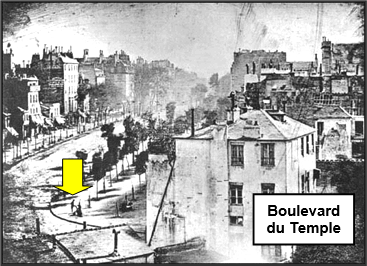 xxxxxThe Daguerre process spread rapidly - it reached
the United States just four weeks after being launched - and
soon “daguerreotypes” of famous landmarks in Europe and North
America were being produced in large numbers. Atxfirst
the exposure time could be as much as an hour - making
portraits impractical - but with the improvement of lenses,
notably by the Hungarian mathematician Jozsef Miska Petzval
(1807-1891) in 1841, exposure time in ideal lighting conditions
could be as little as 20 to 40 seconds. From then on the production
of daguerreotypes became a flourishing industry, particularly
xxxxxThe Daguerre process spread rapidly - it reached
the United States just four weeks after being launched - and
soon “daguerreotypes” of famous landmarks in Europe and North
America were being produced in large numbers. Atxfirst
the exposure time could be as much as an hour - making
portraits impractical - but with the improvement of lenses,
notably by the Hungarian mathematician Jozsef Miska Petzval
(1807-1891) in 1841, exposure time in ideal lighting conditions
could be as little as 20 to 40 seconds. From then on the production
of daguerreotypes became a flourishing industry, particularly 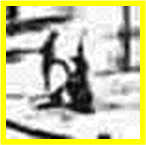 in
the United States, where studios and galleries were set up in the
major cities, and travelling photographers roamed the country in
specially fitted-out wagons. The daguerreotype illustrated here
is by Daguerre himself, produced in 1839. The picture of a
boulevard, it shows (inset) the outline of a man having his shoes
polished. He was probably the first person ever to appear on a
photograph!
in
the United States, where studios and galleries were set up in the
major cities, and travelling photographers roamed the country in
specially fitted-out wagons. The daguerreotype illustrated here
is by Daguerre himself, produced in 1839. The picture of a
boulevard, it shows (inset) the outline of a man having his shoes
polished. He was probably the first person ever to appear on a
photograph!
xxxxxDaguerre added to his
fortune in 1839 by the publication of a best-seller, the
instruction manual entitled An Historical and
Descriptive Account of the Various Processes of the Daguerreotype
and the Diorama. As we shall see below, his method was
eventually superseded by the negative/positive process, sometimes
known as calotype or talbotype.
Invented by the English chemist William Henry Fox Talbot, this was
able to produce a number of prints from a single negative.
xxxxxIncidentally,
in 1840, using the daguerreotype process, the American astronomer John Draper (1811-1882)
took the first photograph of the moon which showed any features.
Meanwhile the French physicist Armand
Fizeau (1819-1896), the first man to
measure the speed of light on the Earth’s surface (achieved in
1849), began to take an interest in photography. In collaboration
with his fellow scientist and countryman, Léon
Foucault (1819-1868), he also adapted
the daguerreotype technique for use in astronomy, and in 1845 took
the first detailed pictures of the Sun’s surface. Six years later
Foucault, by a series of experiments, gained fame by proving that
the Earth rotates about its axis. He received the Copley Medal from
the Royal Society in 1855, and was appointed physicist at the
Imperial Observatory in Paris.
Including:
William Henry
Fox Talbot

xxxxxThe English chemist William Henry Fox Talbot
(1800-1877) became interested in photography in the early
1830s, and in 1835 succeeded in producing an image of a lattice
window at Lacock Abbey, his home in Wiltshire. Like Daguerre he
experimented with the use of sensitized paper, and made public his
method, known as “calotype” eight months before the Frenchman
published his findings in 1839. This process, the first
negative/positive method, was superior to daguerreotype because it
enabled multiple prints to be made from a single negative, a major
feature of modern photographic processing. He later improved the
quality of his prints by using printable steel plates and muslin
screens as part of the printing process. In 1846 he published The Pencil of Nature, the first book to
contain original photographs. Apart from his outstanding
contribution to the development of photography, Talbot also wrote on
mathematics, physics and astronomy, and as a classical scholar he
played a part in deciphering cuneiform inscriptions from the ancient
city of Nineveh in Assyria.
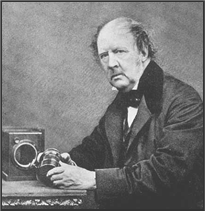 xxxxxThe English chemist William
Henry Fox Talbot (1800-1877) came up
with a similar method to the daguerreotype at almost the same time
as its French inventor, and, in fact, managed to make known his
results in January 1839,
eight months before Daguerre went public. Born in Melbury, Dorset,
and educated at Harrow and Trinity College, Cambridge, he first
became interested in photography while on holiday at Lake
xxxxxThe English chemist William
Henry Fox Talbot (1800-1877) came up
with a similar method to the daguerreotype at almost the same time
as its French inventor, and, in fact, managed to make known his
results in January 1839,
eight months before Daguerre went public. Born in Melbury, Dorset,
and educated at Harrow and Trinity College, Cambridge, he first
became interested in photography while on holiday at Lake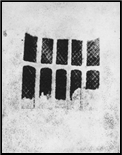 Como, Italy, in the early 1830s. He tried to record images studied
through a camera obscura and a camera lucida, and, on his return, he
succeeded in producing an image of a lattice window (illustrated) at his home, Lacock Abbey in Wiltshire, in 1835.
Produced by using sensitized paper, it is the earliest known
surviving negative on paper.
Como, Italy, in the early 1830s. He tried to record images studied
through a camera obscura and a camera lucida, and, on his return, he
succeeded in producing an image of a lattice window (illustrated) at his home, Lacock Abbey in Wiltshire, in 1835.
Produced by using sensitized paper, it is the earliest known
surviving negative on paper.
xxxxxBy 1841 Talbot had much
improved his use of light-sensitive paper in his developing
technique, and it was in that year that he patented his calotype
process (“calotype” coming from the Greek for beautiful), the very
first negative/positive method. This refinement, which enabled
multiple prints to be made from a single negative, was a decided
advance on the daguerreotype, and marked the beginning of the modern
photographic process. Not surprisingly, it earned him a medal from
the British Royal Society.
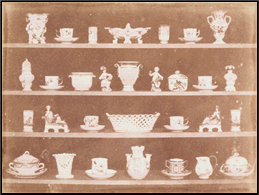 xxxxxIn 1843 he produced a photographic enlarger and then
three years later completed the publication of his The
Pencil of Nature, the first published work containing
original photographs. Published in six installments, its 24 plates
illustrated the very beginnings of photography seen through pictures
of design and architecture. Illustrated here is one of the plates,
entitled Articles in China. Then later,
in the 1850s, he improved the definition of his images further by
using printable steel plates and muslin screens as part of the
printing process.
xxxxxIn 1843 he produced a photographic enlarger and then
three years later completed the publication of his The
Pencil of Nature, the first published work containing
original photographs. Published in six installments, its 24 plates
illustrated the very beginnings of photography seen through pictures
of design and architecture. Illustrated here is one of the plates,
entitled Articles in China. Then later,
in the 1850s, he improved the definition of his images further by
using printable steel plates and muslin screens as part of the
printing process.
xxxxxThe two Frenchmen Joseph
Niépce and Louis Daguerre can rightly claim to have played a
fundamental part in the invention of photography, but Talbot’s
pioneer work, particularly in 1830s and 1840s, also made a vital
contribution to this new art form, and anticipated the lines upon
which it was to develop. Indeed, some would argue that he was
justified to a large extent when he later wrote:
I do not profess to have perfected an art, but to
have commenced
one, the limits of which it is not possible at
present exactly to ascertain.
I only claim to have based this art on a secure
foundation.
xxxxxIndeed, it was on this
secure foundation that the American inventor George Eastman was to
build, and on a grand scale. As we shall see, his famous handheld
“Kodak” camera, produced in 1888 (Vc), was to bring photography to the masses at the “press
of a button”.
xxxxxIncidentally,
Talbot was a talented man in other disciplines. He published a
number of works on mathematics, physics and astronomy, and he was
among the first of the classical scholars to decipher the cuneiform
inscriptions then coming to light during the discovery of the
ancient city of Nineveh in Assyria. A museum dedicated to his work
was opened at Lacock Abbey in 1975. ……
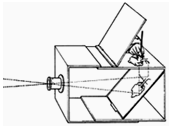 xxxxx…… The camera lucida, which
Talbot used during his holiday in Italy and which awakened his
interest in photography, was invented by the English chemist William
Hyde Wollaston in 1807. It was an optical instrument which helped
the artist to make a more accurate tracing of a particular object. It was while viewing
pictures through this instrument (and the camera obscura) that, as
Talbot later wrote, “the idea occurred to me - how charming it
would be if it were possible to cause these natural images to
imprint themselves durably and remain fixed upon the paper." ……
xxxxx…… The camera lucida, which
Talbot used during his holiday in Italy and which awakened his
interest in photography, was invented by the English chemist William
Hyde Wollaston in 1807. It was an optical instrument which helped
the artist to make a more accurate tracing of a particular object. It was while viewing
pictures through this instrument (and the camera obscura) that, as
Talbot later wrote, “the idea occurred to me - how charming it
would be if it were possible to cause these natural images to
imprint themselves durably and remain fixed upon the paper." ……
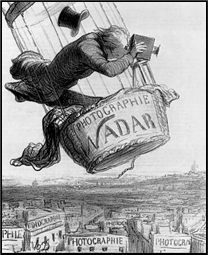 xxxxx…… As
we have seen, the astronomer John Herschel, son of the famous
astronomer Sir William
Herschel, and close friend of the inventor Charles Babbage (1833 W4), was also keen on photography, a word he himself coined,
together with the terms negative and positive. In 1839 his own research convinced
him of the value of sensitized paper in the developing process. ……
xxxxx…… As
we have seen, the astronomer John Herschel, son of the famous
astronomer Sir William
Herschel, and close friend of the inventor Charles Babbage (1833 W4), was also keen on photography, a word he himself coined,
together with the terms negative and positive. In 1839 his own research convinced
him of the value of sensitized paper in the developing process. ……
xxxxx……
Thexfirst aerial photograph was taken in
1858 by Nadar (1820-1910),
the adopted name of the French portrait photographer and ca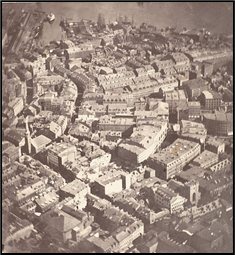 ricaturist
Félix Tournachon.
He took the photograph from his own huge balloon named The
Giant, and it was this balloon that inspired the French
science-fiction writer Jules Verne to write Five
Weeks in a Balloon. And Nadar himself was the inspiration
for one of the characters in Verne’s From Earth
to the Moon. The illustration above is by the French
caricature artist Honoré Daumier in 1862. ……
ricaturist
Félix Tournachon.
He took the photograph from his own huge balloon named The
Giant, and it was this balloon that inspired the French
science-fiction writer Jules Verne to write Five
Weeks in a Balloon. And Nadar himself was the inspiration
for one of the characters in Verne’s From Earth
to the Moon. The illustration above is by the French
caricature artist Honoré Daumier in 1862. ……
xxxxx……
ButxNadar’s early photographs from the air
were lost, so the oldest extant aerial photograph is a view of
Boston (illustrated),
taken by the American photographer James
Wallace Black (1825-1896) from a
tethered balloon in 1860.
Va-1837-1861-Va-1837-1861-Va-1837-1861-Va-1837-1861-Va-1837-1861-Va-1837-1861-Va






 xxxxxAs we have seen, it was the French inventor Joseph
Niépce who, in
1827 (G4),
produced the world’s first permanent photograph taken from nature -
xxxxxAs we have seen, it was the French inventor Joseph
Niépce who, in
1827 (G4),
produced the world’s first permanent photograph taken from nature - xxxxxThe Daguerre process spread rapidly -
xxxxxThe Daguerre process spread rapidly - in
the United States, where studios and galleries were set up in the
major cities, and travelling photographers roamed the country in
specially fitted-
in
the United States, where studios and galleries were set up in the
major cities, and travelling photographers roamed the country in
specially fitted-
 xxxxxThe English chemist William
Henry Fox Talbot (1800-
xxxxxThe English chemist William
Henry Fox Talbot (1800- Como, Italy, in the early 1830s. He tried to record images studied
through a camera obscura and a camera lucida, and, on his return, he
succeeded in producing an image of a lattice window (illustrated) at his home, Lacock Abbey in Wiltshire, in 1835.
Produced by using sensitized paper, it is the earliest known
surviving negative on paper.
Como, Italy, in the early 1830s. He tried to record images studied
through a camera obscura and a camera lucida, and, on his return, he
succeeded in producing an image of a lattice window (illustrated) at his home, Lacock Abbey in Wiltshire, in 1835.
Produced by using sensitized paper, it is the earliest known
surviving negative on paper. xxxxxIn 1843 he produced a photographic enlarger and then
three years later completed the publication of his The
Pencil of Nature, the first published work containing
original photographs. Published in six installments, its 24 plates
illustrated the very beginnings of photography seen through pictures
of design and architecture. Illustrated here is one of the plates,
entitled Articles in China. Then later,
in the 1850s, he improved the definition of his images further by
using printable steel plates and muslin screens as part of the
printing process.
xxxxxIn 1843 he produced a photographic enlarger and then
three years later completed the publication of his The
Pencil of Nature, the first published work containing
original photographs. Published in six installments, its 24 plates
illustrated the very beginnings of photography seen through pictures
of design and architecture. Illustrated here is one of the plates,
entitled Articles in China. Then later,
in the 1850s, he improved the definition of his images further by
using printable steel plates and muslin screens as part of the
printing process. xxxxx…… The camera lucida, which
Talbot used during his holiday in Italy and which awakened his
interest in photography, was invented by the English chemist William
Hyde Wollaston in 1807. It was an optical instrument which helped
the artist to make a more accurate tracing of a particular object. It was while viewing
pictures through this instrument (and the camera obscura) that, as
Talbot later wrote, “the idea occurred to me -
xxxxx…… The camera lucida, which
Talbot used during his holiday in Italy and which awakened his
interest in photography, was invented by the English chemist William
Hyde Wollaston in 1807. It was an optical instrument which helped
the artist to make a more accurate tracing of a particular object. It was while viewing
pictures through this instrument (and the camera obscura) that, as
Talbot later wrote, “the idea occurred to me - xxxxx…… As
we have seen, the astronomer John Herschel, son of the famous
astronomer Sir William
Herschel, and close friend of the inventor Charles Babbage (1833 W4), was also keen on photography, a word he himself coined,
together with the terms negative and positive. In 1839 his own research convinced
him of the value of sensitized paper in the developing process. ……
xxxxx…… As
we have seen, the astronomer John Herschel, son of the famous
astronomer Sir William
Herschel, and close friend of the inventor Charles Babbage (1833 W4), was also keen on photography, a word he himself coined,
together with the terms negative and positive. In 1839 his own research convinced
him of the value of sensitized paper in the developing process. ……  ricaturist
ricaturist


